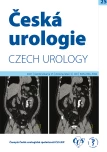Warning time and his role in the conservative treatment of overactive bladder
Authors:
Roman Zachoval 1; Jan Krhut 2
Authors‘ workplace:
Urologická klinika 3. lékařské fakulty Univerzity Karlovy a Fakultní Thomayerovy nemocnice, Praha
1; Urologická klinika Lékařské fakulty Ostravské Univerzity a Fakultní nemocnice, Ostrava
2
Published in:
Ces Urol 2021; 25(3): 175-181
Category:
Review article
Overview
Aim: The aim of this study was to determine the significance of warning time for the evaluation of treatment efficacy of overactive bladder syndrome.
Methods: The PubMed database was searched for all relevant clinical studies evaluating warning time for the medicamentous treatment of overactive bladder.
Results: Four clinical studies evaluating three different drugs for the treatment of overactive bladder were found. The value of warning time increased in active arms compared to placebo in all studies, in three of them significantly. Various methods of evaluating warning time were used in the studies.
Conclusions: Medicamentous treatment of overactive bladder leads to the significant increase of warning time. More clinical studies with a standardized method of evaluation must be performed to determine a role of warning time in the assessment of overactive bladder treatment.
Keywords:
urinary incontinence – overactive bladder – urgency – Warning time
Sources
1. Irwin DE, Milsom I, Hunskaar S, et al. Population-based survey of urinary incontinence, overactive bladder, and other lower urinary tract symptoms in five countries: results of the EPIC study. Eur Urol 2006; 50(6): 1306–1314.
2. Milsom I, Abrams P, Cardozo L, et al. How widespread are the symptoms of an overactive bladder and how are they managed? A population-based prevalence study. BJU Int 2001; 87(9): 760–766.
3. Grinstein E, Gluck O, Digesu A, Deval B. Update on non-invasive treatment for female overactive bladder. J Gynecol Obstet Hum Reprod 2020; 49(3): doi: 10.1016/j.jogoh.2020.101683.
4. Yamada S, Ito Y, Mishijima S, Kadekawa K, Sugaya K. Basic and clinical aspects of antimuscarinic agents used to treat overactive bladder. Pharmacol Ther 2018; 189: 130–148.
5. Cardozo L, Dixon A. Increased warning time with darifenacin: a new concept in the management of urinary urgency. J Urol 2005; 173(4): 1214–1218.
6. Zinner N, Susset J, Gittelman M, et al. Efficacy, tolerability and safety of darifenacine, an M3 selektive receptor antagonist: an investigation of warning time in patients with OAB. Int J Clin Pract 2006; 60(1): 119–126.
7. Karram MM, Toglia MR, Serels SR, et al. Treatment with solifenacin increases warning time and improves symptoms of overactive bladder: Results from VENUS, a randomized, double-blind, placebo-controlled trial. Urology 2009; 73(1): 14–18.
8. Wang AC, Chih S-Y, Chen M-C. Comparison of electric stimulation and oxybutinin chloride in management of overactive bladder with special reference to urinary urgency: a randomized placebo-controlled trial. Urology 2006; 68(5): 999–1004.
9. Chapple CR, Artibani W, Cardozo LD, et al. The role of urinary urgency and its measurement in the overactive bladder symptom syndrome: current concepts and future prospects. BJU Int 2005; 95(3): 335–340.
10. Glavind K, Chancellor M. Antimuscarinics for the treatment of overactive bladder: understanding the role of muscarinic subtype selectivity. Int Urogynecol 2011; 22(8): 907–917.
11. Cardozo L, Coyne KS, Versi E. Validation of the urgency perception scale. BJU Int 2005; 95(4): 591–596.
Labels
Paediatric urologist Nephrology UrologyArticle was published in
Czech Urology

2021 Issue 3
Most read in this issue
- Peroperative histology during robotic-assisted radical prostatectomy with lymphadenectomy: a feasibility study
- Postnatal activation of the hypothalamo-pituitary-gonadal axis (minipuberty) and undescended testicle
- Warning time and his role in the conservative treatment of overactive bladder
- Our technigue of robot-assisted radical cystectomy in women
